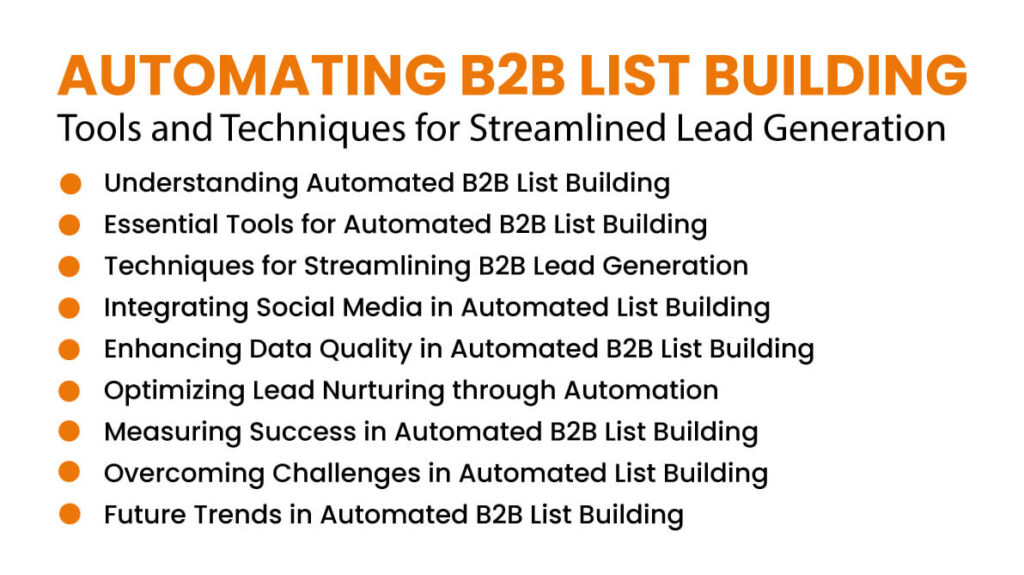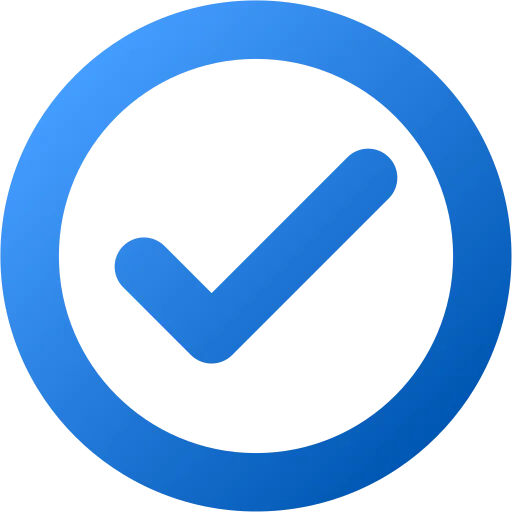
In the realm of B2B marketing, building a high-quality and targeted list of quality leads is paramount. B2B list building is the foundation upon which successful B2B lead generation campaigns are built. It involves identifying and compiling a list of potential prospects who are likely to be interested in a company’s products or services. This targeted approach significantly enhances the efficiency of lead generation efforts, allowing businesses to focus their resources on prospects with genuine potential.
Manual B2B list building, while traditional, is not without its challenges. It’s a time-consuming process that involves searching through various sources, collecting and organizing data, and verifying the accuracy of the information. This manual approach can result in inconsistencies, errors, and inefficiencies. Moreover, the ever-growing volume of data available on the internet makes it practically impossible for manual methods to keep up. Hence, the need for automation arises as a solution to these challenges.
Automated B2B list building presents a range of benefits that go beyond efficiency. Firstly, it enhances accuracy and minimizes human errors in data collection and organization. According to a study by DemandGen, 74% of B2B marketers believe that accurate data is crucial for successful marketing campaigns. Secondly, automation accelerates the process, allowing businesses to generate B2B leads at a faster pace. In fact, research by Ascend2 indicates that 61% of marketers consider lead generation as one of the biggest challenges. Automating the process can significantly alleviate this challenge.
Must Read: How to Build a B2B Email List that Converts: Proven Strategies and Future Trends
Automating B2B List Building: Tools and Techniques for Streamlined Lead Generation

Understanding Automated B2B List Building
Automated B2B list building involves using technology and software tools to streamline the process of identifying and collecting potential leads. These tools utilize advanced algorithms, web scraping techniques, and data enrichment to gather information from various online sources. The result is a comprehensive and up-to-date list of prospects that align with the business’s target audience.
Must Read: Beginner’s Guide to Contact Discovery and B2B List Building
Key Components and Processes in Automated List Building
Automated list building comprises several key components and processes. Web scraping tools extract relevant information from websites, directories, and social media platforms. Lead generation software and platforms help in organizing and managing the collected data.
CRM integration ensures that the gathered leads seamlessly integrate into the company’s customer relationship management system. Marketing automation systems enable businesses to nurture and engage with leads efficiently.
Advantages of Streamlining Lead Generation through Automation
The advantages of automating B2B list building are multifaceted. Firstly, it eliminates manual errors and inconsistencies that often plague manual data collection. According to IBM, poor data quality costs the US economy $3.1 trillion annually.
Secondly, automation saves time and resources, allowing marketers to focus on high-level strategies rather than repetitive tasks. Thirdly, automation enhances targeting accuracy by utilizing AI algorithms to identify prospects that closely match the business’s ideal customer profile.
Must Read: Pro Tips To Build Your B2B Contact List On LinkedIn
Essential Tools for Automated B2B List Building
A. Data Scraping and Web Crawling Solutions
Data scraping and web crawling tools are essential for automated B2B list building. These tools can extract data from various online sources, including websites, directories, and social media platforms. They can collect valuable information such as company names, contact details, industry types, and more. For instance, a study by BrightLocal found that 68% of consumers would stop using a local business if they found incorrect information in online directories.
B. Lead Generation Software and Platforms
Lead generation software and platforms play a pivotal role in managing and organizing the collected data. These tools can segment leads based on various criteria, such as industry, company size, and location. They also provide features for lead tracking, follow-up, and engagement. Research by HubSpot indicates that 74% of companies that weren’t exceeding revenue goals did not know their visitor, lead, MQL, or sales opportunities.
C. CRM Integration for Seamless Data Management
Integrating automated B2B list building with a customer relationship management (CRM) system is crucial for ensuring a seamless flow of data. This integration allows leads to be automatically imported into the CRM, where they can be tracked, analyzed, and assigned to sales teams. According to Nucleus Research, CRM applications can deliver a return on investment (ROI) of $8.71 for every dollar spent.
D. Marketing Automation Systems
Marketing automation systems further enhance the lead generation process by enabling businesses to nurture and engage with leads through automated workflows. These systems can send personalized emails, follow-up messages, and content based on lead behavior and preferences. A study by Marketo indicates that 58% of top-performing companies use marketing automation to nurture leads.
Techniques for Streamlining B2B Lead Generation
A. Identifying Target Audience and Ideal Customer Profiles (ICPs)
Before embarking on automated B2B list building, it’s crucial to define the target audience and ideal customer profiles (ICPs). This involves understanding the characteristics, needs, and pain points of the ideal customers. These insights guide the automated tools in collecting leads that closely align with the business’s offerings.
B. Leveraging AI and Machine Learning for Data Analysis
AI and machine learning play a significant role in data analysis for automated B2B list building. These technologies can analyze vast amounts of data to identify patterns and correlations. For instance, predictive analytics powered by machine learning can help in identifying potential leads with a higher likelihood of converting into customers.
C. Utilizing Predictive Analytics for Lead Scoring and Prioritization
Predictive analytics takes B2B list building to the next level by enabling lead scoring and prioritization. By analyzing historical data and lead behavior, predictive models can assign scores to leads based on their likelihood to convert. This helps sales teams focus their efforts on leads that have a higher potential for conversion.
D. Automated Email List Building and Segmentation
Automated email list building and segmentation ensure that leads receive relevant and personalized communication. Email addresses collected through automated tools can be automatically added to specific email lists based on predefined criteria. This enables businesses to send targeted messages that resonate with the leads’ interests.
Must Read: 5 Smart Steps To Build Your B2B Contact List Quickly
Integrating social media in Automated List Building
A. social media Scraping and Monitoring Tools
Social media platforms are rich sources of data for B2B list building. Social media scraping and monitoring tools can extract information from profiles, posts, and interactions. This data can provide valuable insights into leads’ interests, preferences, and behaviors. According to Statista, there were 4.66 billion social media users worldwide as of April 2021.
B. Automating Lead Generation through Social Media Platforms
Social media platforms themselves offer automation features for lead generation. Ad campaigns and sponsored posts can be set up to target specific demographics and industries. These campaigns can drive traffic to landing pages where leads can provide their contact information in exchange for valuable content.
C. Leveraging Social Media Data for Audience Insights
Data collected from social media platforms can be used to gain deeper audience insights. By analyzing trends and conversations, businesses can understand the pain points and challenges faced by their target audience. These insights can guide content creation and lead nurturing strategies.
Must Read: Beginner’s Guide to Contact Discovery and B2B List Building
Enhancing Data Quality in Automated B2B List Building
A. Data Cleansing and Enrichment Techniques
Automated B2B list building can result in the accumulation of redundant or inaccurate data. Data cleansing and enrichment techniques are essential to maintain data quality. These techniques involve removing duplicate entries, correcting errors, and enriching data with additional information.
B. Validating and Verifying Lead Information
Lead information collected through automated tools should be validated and verified to ensure accuracy. Validating email addresses and contact details helps in reducing bounce rates and ensuring successful communication. According to Validity, 20% of emails in marketing databases never make it to the inbox.
C. Compliance and Privacy Considerations
Automated B2B list building must adhere to data privacy regulations such as GDPR and CCPA. These regulations dictate how personal data should be collected, stored, and processed. Non-compliance can lead to hefty fines and damage to a company’s reputation.
Optimizing Lead Nurturing through Automation
A. Automated Lead Follow-Up and Outreach Sequences
Once leads are collected, automated lead nurturing takes center stage. Automated follow-up and outreach sequences ensure that leads receive timely and relevant communication. Research by Forrester indicates that companies that excel at lead nurturing generate 50% more sales qualified leads at a 33% lower cost.
B. Personalization and Dynamic Content in Automated Emails
Personalization is a cornerstone of effective lead nurturing. Automated emails can be personalized with the lead’s name, company, and specific interests. Moreover, dynamic content can adapt to the lead’s behavior, ensuring that each communication is relevant and valuable.
C. Tracking and Analyzing Lead Engagement
Automated lead nurturing systems provide valuable insights into lead engagement. Metrics such as open rates, click-through rates, and conversion rates offer insights into the effectiveness of communication strategies. According to Epsilon, personalized emails deliver six times higher transaction rates.
Must Read: The Power of Personalization in Database Marketing
Measuring Success in Automated B2B List Building
A. Tracking Key Metrics and KPIs
Measuring the success of automated B2B list building involves tracking key metrics and key performance indicators (KPIs). Metrics such as the number of leads generated, lead quality, and engagement rates provide insights into the effectiveness of the automation efforts.
B. Evaluating Conversion Rates and ROI
Ultimately, the success of B2B list building is determined by conversion rates and return on investment (ROI). By analyzing how many leads progress through the sales funnel and convert into customers, businesses can assess the tangible impact of their automated lead generation efforts.
C. Continuous Improvement through A/B Testing
A/B testing is a valuable technique for optimizing automated lead generation strategies. By testing different approaches to email subject lines, content, and calls-to-action, businesses can identify the most effective strategies for engaging leads. Research by Campaign Monitor indicates that A/B testing can improve conversion rates by 49%.
Overcoming Challenges in Automated List Building
A. Dealing with Incomplete or Inaccurate Data
Automated B2B list building may encounter challenges related to incomplete or inaccurate data. These issues can arise due to errors in data sources or outdated information. Implementing robust data validation and enrichment techniques can help mitigate these challenges.
B. Integrating Automation with Existing Lead Generation Strategies
Businesses often have existing lead generation strategies in place. Integrating automated B2B list building with these strategies can present challenges related to data synchronization and workflow alignment. Proper integration planning and customization are key to addressing these challenges.
C. Avoiding Over-Reliance on Automation and Balancing Human Touch
While automation offers efficiency and accuracy, it’s important to strike a balance between automation and the human touch. Over-reliance on automation can lead to a lack of personalization and genuine human interactions. Combining automation with personalized outreach can enhance lead engagement.
Future Trends in Automated B2B List Building
A. Advancements in AI and Machine Learning Technologies
The future of automated B2B list building lies in advancements in AI and machine learning. These technologies will become more sophisticated in analyzing data patterns and predicting lead behavior. Gartner predicts that by 2024, AI will be a top investment priority for more than 50% of CRM leaders.
B. Integration with IoT and Big Data for Enhanced Lead Insights
The integration of Internet of Things (IoT) and big data will provide a wealth of contextual information for lead insights. Data from IoT devices can offer insights into leads’ behaviors and preferences, allowing for more personalized communication.
C. Personalization and Hyper-Targeting through Automation
Personalization will continue to be a dominant trend in B2B marketing. Automation will enable hyper-targeting, where communication is tailored to the individual needs and preferences of each lead. According to Salesforce, 76% of consumers expect companies to understand their needs and expectations.
Conclusion
In conclusion, automating B2B list building is a game-changing strategy for streamlining lead generation efforts. The challenges of manual list building are effectively addressed through automation, which offers accuracy, efficiency, and scalability. Essential tools such as data scraping solutions, lead generation software, and CRM integration are pivotal for success.
By leveraging AI and machine learning, businesses can enhance data analysis and predictive lead scoring. Social media integration enriches lead insights, while data cleansing techniques maintain data quality. Automated lead nurturing and personalization strategies optimize engagement and conversion rates.
As businesses navigate the data-driven landscape, embracing automation for B2B list building isn’t just a choice but a strategic necessity. The future holds exciting prospects, with advancements in AI, integration with IoT and big data, and unprecedented levels of personalization. By harnessing the power of automation, businesses can propel their lead generation efforts forward, ensuring a steady flow of high-quality leads and driving growth in a competitive market.

Vikas Bhatt is the Co-Founder of ONLY B2B, a premium B2B lead generation company that specializes in helping businesses achieve their growth objectives through targeted marketing & sales campaigns. With 10+ years of experience in the industry, Vikas has a deep understanding of the challenges faced by businesses today and has developed a unique approach to lead generation that has helped clients across a range of industries around the globe. As a thought leader in the B2B marketing community, ONLY B2B specializes in demand generation, content syndication, database services and more.


